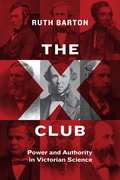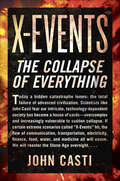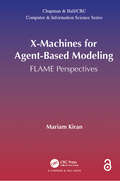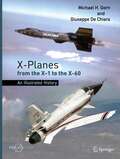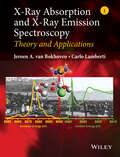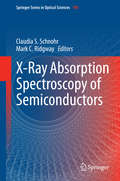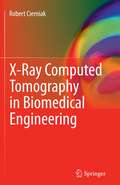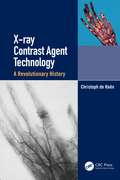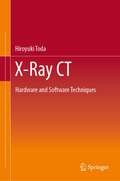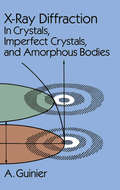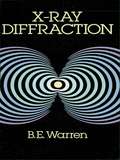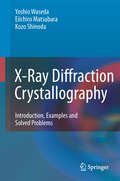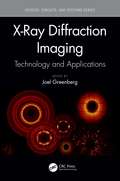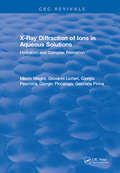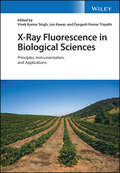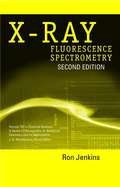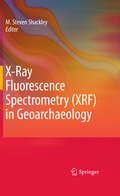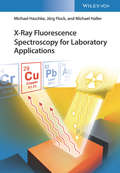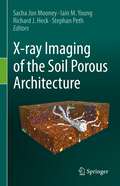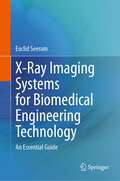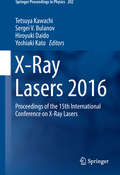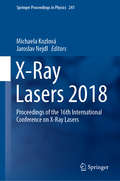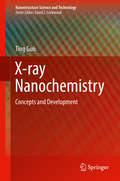- Table View
- List View
The X Club: Power and Authority in Victorian Science
by Ruth BartonIn 1864, amid headline-grabbing heresy trials, members of the British Association for the Advancement of Science were asked to sign a declaration affirming that science and scripture were in agreement. Many criticized the new test of orthodoxy; nine decided that collaborative action was required. The X Club tells their story. These six ambitious professionals and three wealthy amateurs—J. D. Hooker, T. H. Huxley, John Tyndall, John Lubbock, William Spottiswoode, Edward Frankland, George Busk, T. A. Hirst, and Herbert Spencer—wanted to guide the development of science and public opinion on issues where science impinged on daily life, religious belief, and politics. They formed a private dining club, which they named the X Club, to discuss and further their plans. As Ruth Barton shows, they had a clear objective: they wanted to promote “scientific habits of mind,” which they sought to do through lectures, journalism, and science education. They devoted enormous effort to the expansion of science education, with real, but mixed, success. For twenty years, the X Club was the most powerful network in Victorian science—the men succeeded each other in the presidency of the Royal Society for a dozen years. Barton’s group biography traces the roots of their success and the lasting effects of their championing of science against those who attempted to limit or control it, along the way shedding light on the social organization of science, the interactions of science and the state, and the places of science and scientific men in elite culture in the Victorian era.
X-Events: The Collapse of Everything
by John L. CastiA necessary and thought-provoking read for the age of coronavirus, exploring eleven scenarios that may trigger the collapse of the modern world — from pandemics to nuclear apocalypse to robot uprisings — and what we can do to prevent and survive them. In the twenty first century, our world has become impossibly complicated, relying on ever more advanced technology that is developing at an exponential rate. Yet it is a fact of mathematical life that higher and higher levels of complexity lead to systems that are increasingly fragile and susceptible to sudden, spectacular collapse.In this highly provocative and grippingly readable book, John Casti brilliantly argues that today’s advanced, overly complex societies have grown highly vulnerable to extreme events that will ultimately topple civilization like a house of cards. Like Nassim Taleb’s The Black Swan meets Jared Diamond’s Collapse, Casti’s book provides a much-needed wake-up call, sounding a fascinating and frightening warning about civilized society’s inability to recover from a global catastrophe.An eye-opening and necessary read, X-Events is a shocking look at a world teetering on the brink of collapse, and a population under constant threat from pandemic viruses, worldwide communication breakdowns, nuclear winter, or any number of unforeseeable “X-Events.” Fascinating and chilling, X-Events provides a provocative tour of the catastrophic outlier scenarios that could quickly send us crashing back to the preindustrial age – and shows that they may not be as far-fetched as they seem.
The X in Sex: How the X Chromosome Controls Our Lives
by David BainbridgeA tiny scrap of genetic information determines our sex; it also consigns many of us to a life of disease, directs or disrupts the everyday working of our bodies, and forces women to live as genetic chimeras. The culprit--so necessary and yet the source of such upheaval--is the X chromosome, and this is its story. An enlightening and entertaining tour of the cultural and natural history of this intriguing member of the genome, The X in Sex traces the journey toward our current understanding of the nature of X. From its chance discovery in the nineteenth century to the promise and implications of ongoing research, David Bainbridge shows how the X evolved and where it and its counterpart Y are going, how it helps assign developing human babies their sex--and maybe even their sexuality--and how it affects our lives in infinitely complex and subtle ways. X offers cures for disease, challenges our cultural, ethical, and scientific assumptions about maleness and femaleness, and has even reshaped our views of human evolution and human nature.
X-Machines for Agent-Based Modeling: FLAME Perspectives (Chapman & Hall/CRC Computer and Information Science Series)
by Mariam KiranFrom the Foreword: "This book exemplifies one of the most successful approaches to modeling and simulating [the] new generation of complex systems. FLAME was designed to make the building of large scale complex systems models straightforward and the simulation code that it generates is highly efficient and can be run on any modern technology. FLAME was the first such platform that ran efficiently on high performance parallel computers and a version for GPU technology is also available. At its heart, and the reason why it is so efficient and robust, is the use of a powerful computational model ‘Communicating X-machines’ which is general enough to cope with most types of modelling problems. As well as being increasingly important in academic research, FLAME is now being applied in industry in many different application areas. This book describes the basics of FLAME and is illustrated with numerous examples."—Professor Mike Holcombe, University of Sheffield, UK Agent-based models have shown applications in various fields such as biology, economics, and social science. Over the years, multiple agent-based modeling frameworks have been produced, allowing experts with non-computing background to easily write and simulate their models. However, most of these models are limited by the capability of the framework, the time it takes for a simulation to finish, or how to handle the massive amounts of data produced. FLAME (Flexible Large-scale Agent-based Modeling Environment) was produced and developed through the years to address these issues. This book contains a comprehensive summary of the field, covers the basics of FLAME, and shows how concepts of X-machines, can be stretched across multiple fields to produce agent models. It has been written with several audiences in mind. First, it is organized as a collection of models, with detailed descriptions of how models can be designed, especially for beginners. A number of theoretical aspects of software engineering and how they relate to agent-based models are discussed for students interested in software engineering and parallel computing. Finally, it is intended as a guide to developers from biology, economics, and social science, who want to explore how to write agent-based models for their research area. By working through the model examples provided, anyone should be able to design and build agent-based models and deploy them. With FLAME, they can easily increase the agent number and run models on parallel computers, in order to save on simulation complexity and waiting time for results. Because the field is so large and active, the book does not aim to cover all aspects of agent-based modeling and its research challenges. The models are presented to show researchers how they can build complex agent functions for their models. The book demonstrates the advantage of using agent-based models in simulation experiments, providing a case to move away from differential equations and build more reliable, close to real, models. The Open Access version of this book, available at https://doi.org/10.1201/9781315370729, has been made available under a Creative Commons Attribution-Non Commercial-No Derivatives 4.0 license.
X-Planes from the X-1 to the X-60: An Illustrated History (Springer Praxis Books)
by Michael H. Gorn Giuseppe De ChiaraForeword by Dr. Roger D. Launius, Former NASA Chief Historian For the past 75 years, the U.S. government has invested significant time and money into advanced aerospace research, as evidenced by its many experimental X-plane aircraft and rockets. NASA's X-Planes asks a simple question: What have we gained from it all? To answer this question, the authors provide a comprehensive overview of the X-plane’s long history, from the 1946 X-1 to the modern X-60. The chapters describe not just the technological evolution of these models, but also the wider story of politics, federal budgets, and inter-agency rivalries surrounding them. The book is organized into two sections, with the first covering the operational X-planes that symbolized the Cold War struggle between the U.S. and the U.S.S.R, and the second section surveying post-Cold War aircraft and spacecraft. Featuring dozens of original illustrations of X-plane cross-sections, in-flight profiles, close-ups, and more, this book will educate general readers and specialists alike.
X-Ray Absorption and X-Ray Emission Spectroscopy
by Jeroen A. van Bokhoven Carlo LambertiDuring the last two decades, remarkable and often spectacular progress has been made in the methodological and instrumental aspects of x-ray absorption and emission spectroscopy. This progress includes considerable technological improvements in the design and production of detectors especially with the development and expansion of large-scale synchrotron reactors All this has resulted in improved analytical performance and new applications, as well as in the perspective of a dramatic enhancement in the potential of x-ray based analysis techniques for the near future. This comprehensive two-volume treatise features articles that explain the phenomena and describe examples of X-ray absorption and emission applications in several fields, including chemistry, biochemistry, catalysis, amorphous and liquid systems, synchrotron radiation, and surface phenomena. Contributors explain the underlying theory, how to set up X-ray absorption experiments, and how to analyze the details of the resulting spectra. X-Ray Absorption and X-ray Emission Spectroscopy: Theory and Applications: Combines the theory, instrumentation and applications of x-ray absorption and emission spectroscopies which offer unique diagnostics to study almost any object in the Universe. Is the go-to reference book in the subject for all researchers across multi-disciplines since intense beams from modern sources have revolutionized x-ray science in recent years Is relevant to students, postdocurates and researchers working on x-rays and related synchrotron sources and applications in materials, physics, medicine, environment/geology, and biomedical materials
X-Ray Absorption Spectroscopy of Semiconductors
by Claudia S. Schnohr Mark C. RidgwayX-ray Absorption Spectroscopy (XAS) is a powerful technique with which to probe the properties of matter, equally applicable to the solid, liquid and gas phases. Semiconductors are arguably our most technologically-relevant group of materials given they form the basis of the electronic and photonic devices that now so widely permeate almost every aspect of our society. The most effective utilisation of these materials today and tomorrow necessitates a detailed knowledge of their structural and vibrational properties. Through a series of comprehensive reviews, this book demonstrates the versatility of XAS for semiconductor materials analysis and presents important research activities in this ever growing field. A short introduction of the technique, aimed primarily at XAS newcomers, is followed by twenty independent chapters dedicated to distinct groups of materials. Topics span dopants in crystalline semiconductors and disorder in amorphous semiconductors to alloys and nanometric material as well as in-situ measurements of the effects of temperature and pressure. Summarizing research in their respective fields, the authors highlight important experimental findings and demonstrate the capabilities and applications of the XAS technique. This book provides a comprehensive review and valuable reference guide for both XAS newcomers and experts involved in semiconductor materials research.
X-Ray Computed Tomography in Biomedical Engineering
by Robert CierniakComputed Tomography gives a detailed overview of various aspects of computed tomography. It discusses X-ray CT tomography from a historical point of view, the design and physical operating principles of computed tomography apparatus, the algorithms of image reconstruction and the quality assessment criteria of tomography scanners. Algorithms of image reconstruction from projections, a crucial problem in medical imaging, are considered in depth. The author gives descriptions of the reconstruction methods related to tomography scanners with a parallel X-ray beam, trough solutions with fan-shaped beam and successive modifications of spiral scanners. Computed Tomography contains a dedicated chapter for those readers who are interested in computer simulations based on studies of reconstruction algorithms. The information included in this chapter will enable readers to create a simulation environment in which virtual tomography projections can be obtained in all basic projection systems. This monograph is a valuable study on computed tomography that will be of interest to advanced students and researchers in the fields of biomedical engineering, medical electronics, computer science and medicine.
X-ray Contrast Agent Technology: A Revolutionary History
by Christoph de HaenThis book documents the fascinating history of radiological techniques that use contrast agents. The text includes many of the fundamental documentary sources that bring to life the social and scientific background of the discoveries, the personalities of the discoverers, and implementation of new technologies. Such agents when used with X-rays allow clinicians to distinguish anatomical structures with nearly identical densities. Focus is on urological and angiographic uses of contrast agents. Key selling features: Documents and thoroughly references the history of contrast agent development Reviews the priority and importance of patents Discusses the role that important individual scientists and leading research institutions have played in technology development and implementation
X-Ray CT: Hardware and Software Techniques
by Hiroyuki TodaThis book provides easy-to-understand explanations to systematically and comprehensively describe the X-ray CT technologies, techniques, and skills used for industrial and scientific purposes. Included are many references along with photographs, figures, and equations prepared by the author. These features all facilitate the reader's gaining a deeper understanding of the topics being discussed. The book presents expertise not only on fundamentals but also about hardware, software, and analytical methods for the benefit of technical users. The book targets engineers, researchers, and students who are involved in research, development, design, and quality assurance in industry and academia.
X-Ray Diffraction: In Crystals, Imperfect Crystals, and Amorphous Bodies (Dover Books On Physics Series)
by A. GuinierThis valuable text begins with the general theory of diffraction through the use of Fourier transforms. The author then applies the general results to various atomic structures including amorphous bodies, crystals, and imperfect crystals, whereby the elementary laws of x-ray diffraction from ideal structures follow as a special case. The presentation has been carefully developed to illustrate clearly the meaning of the general equations essential for the study of more complex cases.Readers are assumed to be familiar with the elements of crystallography and x-ray diffraction, and the author has not discussed the problem of determining crystal structures. Rather the focus is on the great variety of imperfect crystals as well as amorphous bodies and liquids. The book should thus be especially useful solid-state physicists, materials scientists, chemists, and biologists with an interest in the scattering from defective structures. More generally, it will benefit all who require a thorough understanding of diffraction theory in order to interpret properly the information provided by modern x-ray diffraction instruments on line profiles, line intensities, diffuse scattering and other phenomena associated with disorder.
X-Ray Diffraction
by B. E. WarrenBasic diffraction theory has numerous important applications in solid-state physics and physical metallurgy, and this graduate-level text is the ideal introduction to the fundamentals of the discipline. Development is rigorous (throughout the book, the treatment is carried far enough to relate to experimentally observable quantities) and stress is placed on modern applications to nonstructural problems such as temperature vibration effects, order-disorder phenomena, crystal imperfections, the structure of amorphous materials, and the diffraction of x-rays in perfect crystals.Carefully selected problems have been included at the end of each chapter to help the student test his grasp of the material.
X-Ray Diffraction Crystallography
by Eiichiro Matsubara Kozo Shinoda Yoshio WasedaX-ray diffraction crystallography for powder samples is a well-established and widely used method. It is applied to materials characterization to reveal the atomic scale structure of various substances in a variety of states. The book deals with fundamental properties of X-rays, geometry analysis of crystals, X-ray scattering and diffraction in polycrystalline samples and its application to the determination of the crystal structure. The reciprocal lattice and integrated diffraction intensity from crystals and symmetry analysis of crystals are explained. To learn the method of X-ray diffraction crystallography well and to be able to cope with the given subject, a certain number of exercises is presented in the book to calculate specific values for typical examples. This is particularly important for beginners in X-ray diffraction crystallography. One aim of this book is to offer guidance to solving the problems of 90 typical substances. For further convenience, 100 supplementary exercises are also provided with solutions. Some essential points with basic equations are summarized in each chapter, together with some relevant physical constants and the atomic scattering factors of the elements.
X-Ray Diffraction Imaging: Technology and Applications (Devices, Circuits, and Systems)
by Joel GreenbergThis book explores novel methods for implementing X-ray diffraction technology as an imaging modality, which have been made possible through recent breakthroughs in detector technology, computational power, and data processing algorithms. The ability to perform fast, spatially-resolved X-ray diffraction throughout the volume of a sample opens up entirely new possibilities in areas such as material analysis, cancer diagnosis, and explosive detection, thus offering the potential to revolutionize the fields of medical, security, and industrial imaging and detection. Featuring chapters written by an international selection of authors from both academia and industry, the book provides a comprehensive discussion of the underlying physics, architectures, and applications of X-ray diffraction imaging that is accessible and relevant to neophytes and experts alike. Teaches novel methods for X-ray diffraction imaging Comprehensive and self-contained discussion of the relevant physics, imaging techniques, system components, and data processing algorithms Features state-of-the-art work of international authors from both academia and industry. Includes practical applications in the medical, industrial, and security sectors
X-Ray Diffraction of Ions in Aqueous Solutions: Hydration And Complex Formation
by Mauro Magini Giovanni Licheri Giorgio Paschina Giorgio Piccaluga Gabriella PinnaFirst Published in 2018. This book is devoted to the description of the basic principles of X-ray diffraction on noncrystalline systems and to the correlation between diffracted intensities and structure. It presents a critical comparison between the results obtained by XRD and the ones obtained by neutron diffraction.
X-Ray Fluorescence in Biological Sciences: Principles, Instrumentation, and Applications
by Vivek Kumar Singh Jun Kawai Durgesh Kumar TripathiX-Ray Fluorescence in Biological Sciences Discover a comprehensive exploration of X-ray fluorescence in chemical biology and the clinical and plant sciences In X-Ray Fluorescence in Biological Sciences: Principles, Instrumentation, and Applications, a team of accomplished researchers delivers extensive coverage of the application of X-ray fluorescence (XRF) in the biological sciences, including chemical biology, clinical science, and plant science. The book also explores recent advances in XRF imaging techniques in these fields. The authors focus on understanding and investigating the intercellular structures and metals in plant cells, with advanced discussions of recently developed micro-analytical methods, like energy dispersive X-ray fluorescence spectrometry (EDXRF), total reflection X-ray fluorescence spectrometry (TXRF), micro-proton induced X-ray emission (micro-PIXE), electron probe X-ray microanalysis (EPXMA), synchrotron-based X-ray fluorescence microscopy (SXRF, SRIXE, or micro-XRF) and secondary ion mass spectrometry (SIMS). With thorough descriptions of protocols and practical approaches, the book also includes: A thorough introduction to the historical background and fundamentals of X-ray fluorescence, as well as recent developments in X-ray fluorescence analysis Comprehensive explorations of the general properties, production, and detection of X-rays and the preparation of samples for X-ray fluorescence analysis Practical discussions of the quantification of prepared samples observed under X-ray fluorescence and the relation between precision and beam size and sample amount In-depth examinations of wavelength-dispersive X-ray fluorescence and living materials Perfect for students and researchers studying the natural and chemical sciences, medical biology, plant physiology, agriculture, and botany, X-Ray Fluorescence in Biological Sciences: Principles, Instrumentation, and Applications will also earn a place in the libraries of researchers at biotechnology companies.
X-Ray Fluorescence Spectrometry
by Ron JenkinsX-ray fluorescence spectroscopy, one of the most powerful and flexible techniques available for the analysis and characterization of materials today, has gone through major changes during the past decade.Fully revised and expanded by 30%, X-Ray Fluorescence Spectrometry, Second Edition incorporates the latest industrial and scientific trends in all areas. It updates all previous material and adds new chapters on such topics as the history of X-ray fluorescence spectroscopy, the design of X-ray spectrometers, state-of-the-art applications, and X-ray spectra.Ron Jenkins draws on his extensive experience in training and consulting industry professionals for this clear and concise treatment, covering first the basic aspects of X rays, then the methodology of X-ray fluorescence spectroscopy and available instrumentation. He offers a comparison between wavelength and energy dispersive spectrometers as well as step-by-step guidelines to X-ray spectrometric techniques for qualitative and quantitative analysis-from specimen preparation to real-world industrial application.Favored by the American Chemical Society and the International Centre for Diffraction Data, X-Ray Fluorescence Spectrometry, Second Edition is an ideal introduction for newcomers to the field and an invaluable reference for experienced spectroscopists-in chemical analysis, geology, metallurgy, and materials science.An up-to-date review of X-ray spectroscopic techniques. This proven guidebook for industry professionals is thoroughly updated and expanded to reflect advances in X-ray analysis over the last decade. X-Ray Fluorescence Spectrometry, Second Edition includes:* The history of X-ray fluorescence spectrometry-new to this edition.* A critical review of the most useful X-ray spectrometers.* Techniques and procedures for quantitative and qualitative analysis.* Modern applications and industrial trends.* X-ray spectra-new to this edition.
X-Ray Fluorescence Spectrometry (XRF) in Geoarchaeology
by M. Steven ShackleySince the 1960s, x-ray fluorescence spectrometry (XRF), both wavelength and energy-dispersive have served as the workhorse for non-destructive and destructive analyses of archaeological materials. Recently eclipsed by other instrumentation such as LA-ICP-MS, XRF remains the mainstay of non-destructive chemical analyses in archaeology, particularly for volcanic rocks, and most particularly for obsidian. In a world where heritage and repatriation issues drive archaeological method and theory, XRF remains an important tool for understanding the human past, and will remain so for decades to come. Currently, there is no comprehensive book in XRF applications in archaeology at a time when the applications of portable XRF and desktop XRF instrumentation are exploding particularly in anthropology and archaeology departments worldwide. The contributors to this volume are the experts in the field, and most are at the forefront of the newest applications of XRF to archaeological problems. It covers all relevant aspects of the field for those using the newest XRF technologies to deal with very current issues in archaeology.
X-Ray Fluorescence Spectroscopy for Laboratory Applications
by Michael Haschke Jörg Flock Michael HallerProvides comprehensive coverage on using X-ray fluorescence for laboratory applications This book focuses on the practical aspects of X-ray fluorescence (XRF) spectroscopy and discusses the requirements for a successful sample analysis, such as sample preparation, measurement techniques and calibration, as well as the quality of the analysis results. X-Ray Fluorescence Spectroscopy for Laboratory Applications begins with a short overview of the physical fundamentals of the generation of X-rays and their interaction with the sample material, followed by a presentation of the different methods of sample preparation in dependence on the quality of the source material and the objective of the measurement. After a short description of the different available equipment types and their respective performance, the book provides in-depth information on the choice of the optimal measurement conditions and the processing of the measurement results. It covers instrument types for XRF; acquisition and evaluation of X-Ray spectra; analytical errors; analysis of homogeneous materials, powders, and liquids; special applications of XRF; process control and automation. An important resource for the analytical chemist, providing concrete guidelines and support for everyday analyses Focuses on daily laboratory work with commercially available devices Offers a unique compilation of knowledge and best practices from equipment manufacturers and users Covers the entire work process: sample preparation, the actual measurement, data processing, assessment of uncertainty, and accuracy of the obtained results X-Ray Fluorescence Spectroscopy for Laboratory Applications appeals to analytical chemists, analytical laboratories, materials scientists, environmental chemists, chemical engineers, biotechnologists, and pharma engineers.
X-ray Imaging of the Soil Porous Architecture
by Sacha Jon Mooney Iain M. Young Richard J. Heck Stephan PethThe advent of X-ray Computed Tomography (CT) as a tool for the soil sciences almost 40 years ago has revolutionised the field. Soil is the fragile, thin layer of material that exists above earth’s geological substrates upon which so much of life on earth depends. However a major limitation to our understanding of how soils behave and function is due to its complex, opaque structure that hinders our ability to assess its porous architecture without disturbance. X-ray imagery has facilitated the ability to truly observe soil as it exists in three dimensions and across contrasting spatial and temporal scales in the field in an undisturbed fashion. This book gives a comprehensive overview of the “state of the art” in a variety of application areas where this type of imaging is used, including soil water physics and hydrology, agronomic management of soils, and soil-plant-microbe interactions. It provides the necessary details for entry level readers in the crucial areas of sample preparation, scanner optimisation and image processing and analysis. Drawing on experts across the globe, from both academia and industry, the book covers the necessary “dos and don’ts”, but also offers insights into the future of both technology and science. The wider application of the book is provided by dedicated chapters on how the data from such imagery can be incorporated into models and how the technology can be interfaced with other relevant technical applications. The book ends with a future outlook from the four editors, each of whom has over 20 years of experience in the application of X-ray CT to soil science.
X-Ray Imaging Systems for Biomedical Engineering Technology: An Essential Guide
by Euclid SeeramThis book addresses X-Ray Imaging Systems intended for biomedical engineering technology students and practitioners, and deals with the major technical components of x-ray imaging modalities. These modalities include film-based imaging, digital radiography, and computed tomography. Furthermore, principles and concepts essential to the understanding of how these modalities function will be described. These include fundamental radiation physics, imaging informatics, quality control, and radiation protection considerations. X-Ray Imaging Systems for Biomedical Engineering Technology: An Essential Guide is intended for biomedical engineering technologists, who provide technical advice and services relating to digital radiography and CT departments not only in hospitals but in private facilities as well. Students in radiological technology programs may also find this to be a useful resource.
X-Ray Lasers 1996: Proceedings of the Fifth International Conference on X-Ray Lasers held in Lund, Sweden, 10-14 June, 1996
by S Svanberg; C-G WahlströmX-Ray Lasers 1996 provides not only an overview and progress report on this fast moving field, but also important reference material on which future work can be built. Topics covered include collisional x-ray lasers, table-top x-ray lasers, beam optics, x-ray optics, OFI and photo-pumped schemes, capillary schemes, international laser facilities, XUV nonlinear mixing, alternative soft x-ray sources, diagnostics, and applications. The volume is an essential addition to the libraries of researchers in the field.
X-Ray Lasers 2016: Proceedings Of The 15th International Conference On X-ray Lasers (Springer Proceedings In Physics #202)
by Tetsuya Kawachi Sergei V. Bulanov Hiroyuki Daido Yoshiaki KatoDiscusses the latest research topics related to coherent x-ray sources.<P><P> Includes several new proposals for free-electron laser (FEL) using laser- accelerated electrons.<P> Describes the latest methodology and techniques for x-ray coherent diffraction imaging and x-ray interferometry.<P> These proceedings comprise a selection of invited and contributed papers presented at the 15th International Conference on X-Ray Lasers (ICXRL 2016), held at the Nara Kasugano International Forum, Japan, from May 22 to 27, 2016. This conference was part of an ongoing series dedicated to recent developments in the science and technology of x-ray lasers and other coherent x-ray sources with additional focus on supporting technologies, instrumentation and applications. <P> The book showcases recent advances in the generation of intense, coherent x-rays, the development of practical devices and their applications across a wide variety of fields. It also discusses emerging topics such as plasma-based x-ray lasers, 4th generation accelerator-based sources and higher harmonic generations, as well as other x-ray generation schemes.
X-Ray Lasers 2018: Proceedings of the 16th International Conference on X-Ray Lasers (Springer Proceedings in Physics #241)
by Michaela Kozlová Jaroslav NejdlThese proceedings gather a selection of invited and contributed papers presented during the 16th International Conference on X-Ray Lasers (ICXRL 2018), held in Prague, Czech Republic, from 7 to 12 October 2018. The conference is part of an ongoing series dedicated to recent developments in the science and technology of X-ray lasers and other coherent X-ray sources, with an additional focus on supporting technologies, instrumentation and applications. The book highlights advances in a wide range of fields including laser and discharge-pumped plasma X-ray lasers, the injection and seeding of X-ray amplifiers, high-order harmonic generation and ultrafast phenomena, X-ray free electron lasers, novel schemes for (in)coherent XUV, X-ray and γ-ray generation, XUV and X-ray imaging, optics and metrology, X-rays and γ-rays for fundamental science, the practical implementation of X-ray lasers, XFELs and super-intense lasers, and the applications and industrial uses of X-ray lasers.
X-ray Nanochemistry: Concepts And Development (Nanostructure Science And Technology Ser.)
by Ting GuoThis book describes the latest developments in the new research discipline of X-ray nanochemistry, which uses nanomaterials to enhance the effectiveness of X-ray irradiation. Nanomaterials now can be synthesized in such a way as to meet the demand for complex functions that enhance the X-ray effect. Innovative methods of delivering the X-rays, which can interact with those nanomaterials much more strongly than energetic electrons and gamma rays, also create new opportunities to enhance the X-ray effect. As a result, new concepts are conceived and new developments are made in the last decade, which are discussed and summarized in this book. This book will help define the discipline and encourage more students and scientists to work in this discipline. These efforts will eventually lead to formation of a full set of physical, chemical and materials principles for this new research field.
